Inca Trail to Machu Picchu
The Inca Trail is one of the most emblematic and ancient trekking routes in the world, combining adventure, history and nature. This trek follows ancient trails used by the Incas, crossing breathtaking landscapes of the Andes Mountains, from lush cloud forests to majestic snow-capped peaks. Along the way, travelers can discover archaeological ruins hidden among the vegetation and experience the ancient culture up close. The journey culminates at the majestic citadel of Machu Picchu, an architectural marvel that has fascinated the world for centuries, offering an unforgettable experience for both its beauty and historical significance.
-
2-Day Short Inca Trail:
Embrace the essence of the Inca Trail in a condensed and action-packed journey. Start in serene Ollantaytambo and ascend to Inti Punku, savouring the panoramic views and iconic revelation of Machu Picchu.
-
4-Day Classic Inca Trail:
The gold standard, offering a balanced blend of challenge and awe-inspiring scenery. Hike iconic sections like Dead Woman's Pass and Sun Gate, and soak in the magic of Machu Picchu at sunrise.
-
5-Day In-Depth Exploration:
For dedicated explorers, this immersive trek delves into the hidden wonders of the trail. Learn from local communities and arrive at Machu Picchu with a richer understanding of its history.
-
Salkantay + Inca Trail 6 Days:
Combine the experience of the Salkantay snowy route with the Inca Trail hike and be assured of a unique experience, landscapes and privileged views.
-
3-Day Classic Inca Trail:
Embark on a captivating three-day, two-night Inca Trail adventure covering a distance of 23 miles or 45 kilometers, leading to the majestic Machu Picchu.
Start planning your ascent to Machu Picchu today! Contact us for personalized itineraries and let’s craft your perfect Inca Trail journey.
Things you should know about the Inca Trail (fun facts about the Inca Trail)
Did you know that the Inca Trail is just a small fraction of the vast network of roads known as the **Qhapaq Ñan**, which spanned more than 40,000 km throughout the Inca Empire, connecting Peru, Bolivia, Ecuador, Colombia, Chile and Argentina.
If you are thinking of doing the Inca Trail to Machu Picchu, there are several important things you should know to ensure you have a safe and rewarding experience: **Book in advance** permits for the Inca Trail are limited and can sell out months in advance, especially in high season (May to September). It is advisable to reserve your spot **6 months in advance**.
Difficulty of the Inca Trail
The Inca Trail is a trekking experience that presents a considerable physical challenge, although accessible to people with good physical condition and adequate preparation. The route crosses mountainous landscapes, with steep climbs and steep descents, as well as stretches with irregular stone stairs and narrow paths. The altitude is another aspect that adds difficulty, since a considerable elevation is reached, which can cause altitude sickness in some people. The combination of physical exertion and the need for acclimatization makes the Inca Trail a demanding route, although extremely rewarding for its spectacular views and immersion in Inca history. Proper preparation and equipment are key for this trek in the heart of Peru.
What campsites are there during the Inca Trail
During the Inca Trail to Machu Picchu, the main campsites used to rest and spend the night are Ayapata, Pacaymayo, Chaquicocha and Wiñay Wayna. These camps are distributed throughout the four-day trek and offer different types of experience in terms of altitude, views and services available.
1. Ayapata (First camp):
After the first day of trekking, the group arrives at Ayapata, which is located in an area surrounded by Andean vegetation, at a moderate altitude. Here you can see nearby mountains and rivers, and it is a good stop to acclimatize a bit to the altitude before facing the more intense ascents.
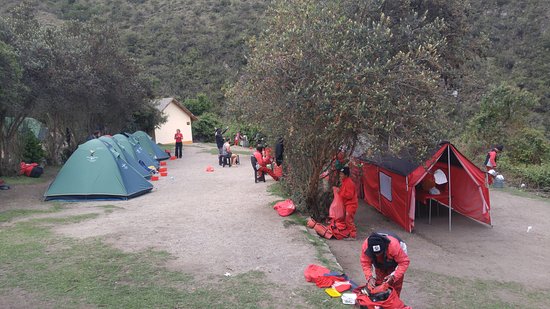
2. Pacaymayo (Second camp):
Pacaymayo has a mountain setting that offers stunning panoramic views and clear skies at night, ideal for stargazing. In addition, this camp has some basic facilities, such as restrooms and areas to set up tents. Being in an elevated location, temperatures can be cold, especially at night, so it is important to be well prepared for the weather.
Pacaymayo is also a strategic point to enjoy the Andean scenery and reflect on the rich history of the Inca Trail, while recharging energy for the next day’s trek to Chaquicocha. This camp is usually one of the most memorable, both for the challenge of getting here and for the breathtaking views and air.
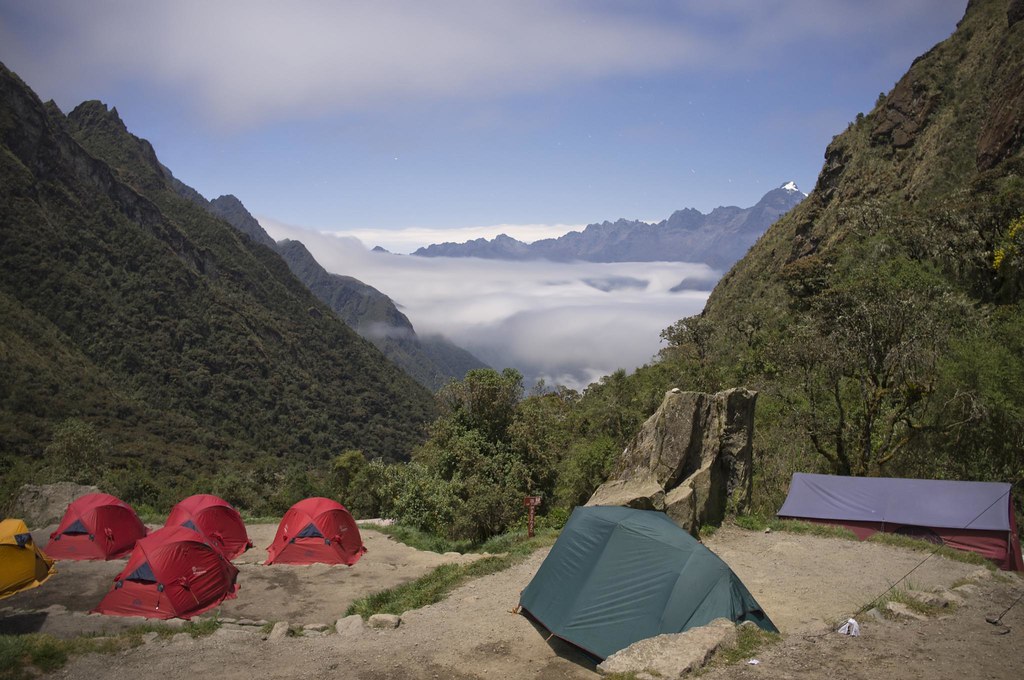
3. Chaquicocha (Third camp):
This camp is an ideal place to observe the transition of landscapes between the highlands and the high jungle. The proximity to the mist rising from the valley creates a serene and somewhat ethereal atmosphere, perfect for relaxation and reflection. Chaquicocha also offers spectacular views of the surrounding mountains, especially at sunrise, when the sunlight begins to illuminate the vegetation and reveal the hidden beauty of this.
Facilities at Chaquicocha are basic, with areas to set up tents and bathrooms. Due to the altitude and humidity of the site, temperatures can be cool and the atmosphere is somewhat humid, which enhances the feeling of being immersed in nature. It is a quiet and less crowded camp, which allows a more intimate connection with the environment and an emotional preparation for the last day on the way to Machu Picchu.
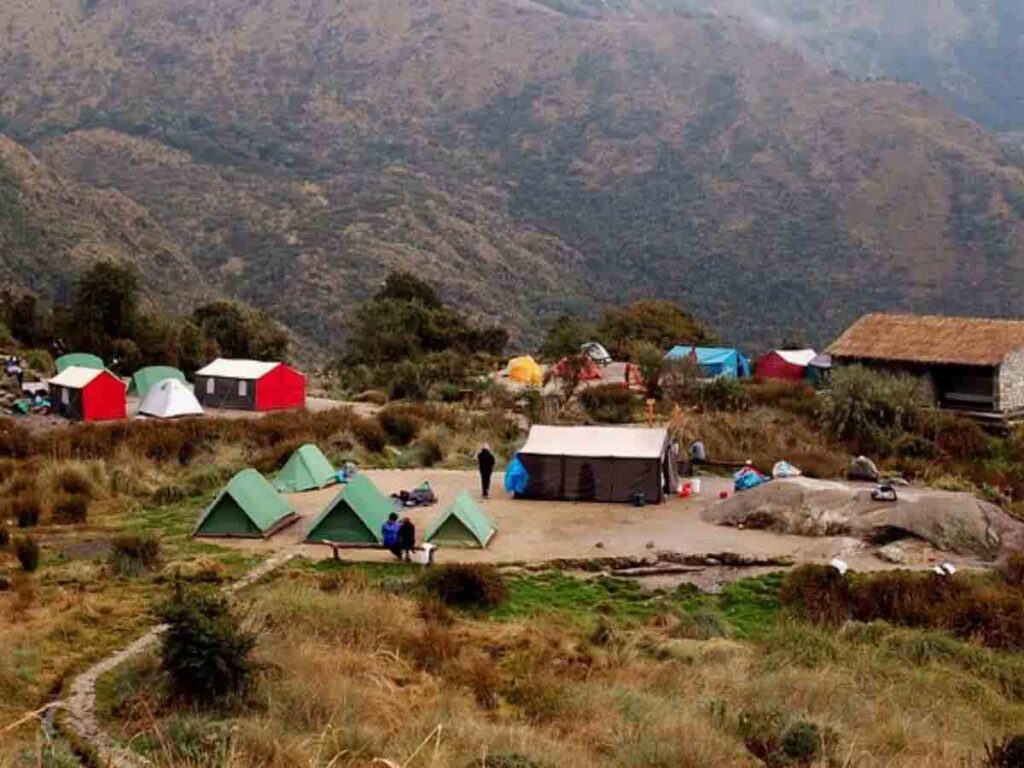
4. Wiñay Wayna (Fourth camp):
The ruins of Wiñay Wayna are a set of agricultural terraces and buildings that show the constructive skill of the Incas. From here, it is possible to enjoy spectacular views of the valley and the Urubamba River, and the proximity of the ruins allows you to explore and admire the Inca architecture before the last stage to Machu Picchu. The atmosphere is peaceful, surrounded by orchids, mosses and ferns, and is imbued with a sense of mysticism and mysticism.
Wiñay Wayna is also a camp that has basic services, and being closer to Machu Picchu, there is a certain excitement among trekkers knowing that the goal is near. From here, the sunrise on the last day is especially memorable, as trekkers leave early to reach the Sun Gate (Inti Punku) and get the first view of Machu Picchu.
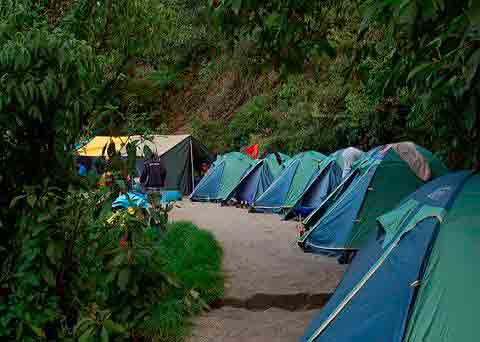
Mountains known during the Inca Trail
Along the Inca Trail, you will encounter several spectacular mountains that offer panoramic views and unique landscapes of the Andes Mountains. These mountains not only beautify the surroundings, but also provide historical and spiritual context, as many were considered sacred by the Incas.
Warmiwañusca: This mountain, whose name in Quechua means “Pass of the Dead Woman”, is one of the highest points on the Inca Trail, reaching an altitude of approximately 4,200 meters. The climb up to the Warmiwañusca pass is the most challenging stretch of the entire route, but the view from the top rewards the effort. From here, you can see extensive valleys and other nearby mountains, surrounded by an impressive landscape that mixes nature with a mystical touch.
Another mountain that you will appreciate during the Inca Trail is Veronica, Huacay Wilca, the silhouette of Veronica is impressive due to its snow-covered summit, which shines especially at sunrise and sunset, when the sun’s rays illuminate it. In addition to its beauty, this mountain is also an “Apu”, or protective spirit, which is believed to watch over and protect travelers and the region. Although it is not directly on the route, its proximity allows its details to be clearly observed, offering a constant reminder of the majesty of the Andes.
Veronica Mountain provides a spectacular contrast to the valleys and cloud forest you pass through on the Inca Trail.
Archaeological sites along the Inca Trail
During the Inca Trail to Machu Picchu, you can explore several impressive archaeological sites. These vestiges are testimony to the skill and spirituality of the Inca Empire. Here is a list of the main archaeological sites you will encounter.
1. Llactapata
This is the first archaeological site of the tour and is characterized by its wide agricultural terraces and remains of residential constructions. Llactapata, whose name means “High City”, seems to have been an important center of cultivation and a place of rest.
2. Runkuraqay
Located after ascending the first high pass, Runkuraqay consists of a series of semicircular structures and terraces that probably served as a guard or control post. Its design and elevated location offer an impressive view of the surroundings and show the Inca’s ability to adapt to mountainous terrain.
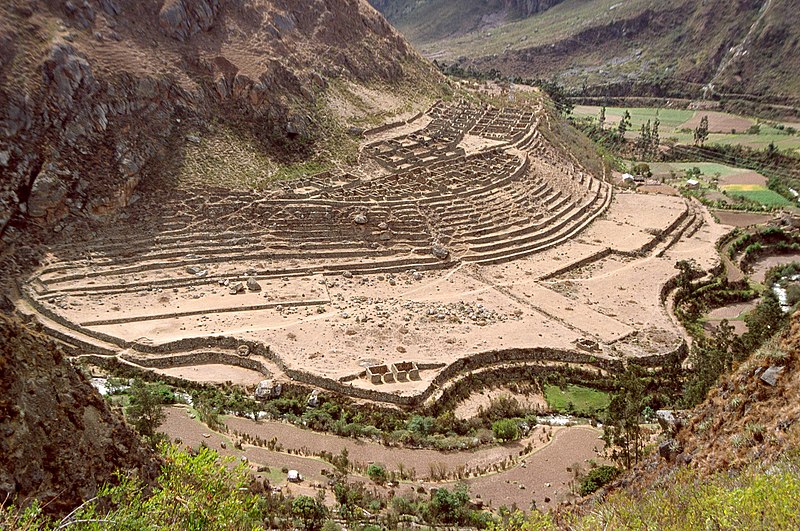
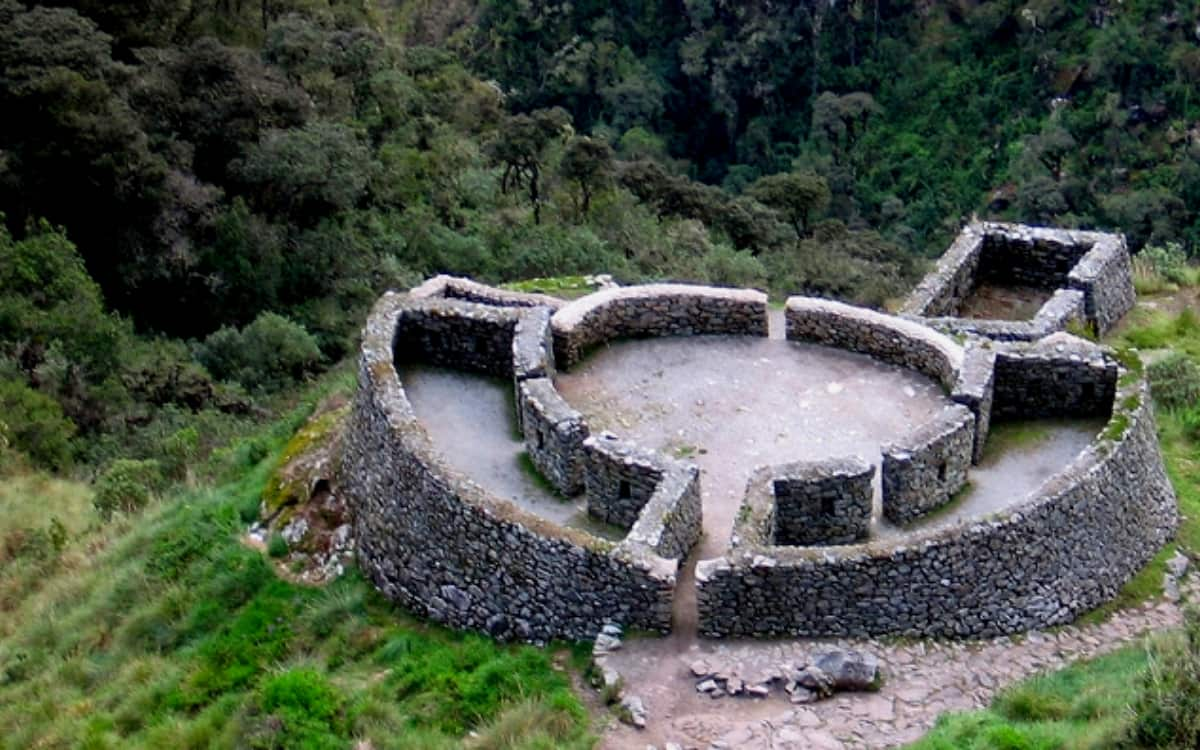
3. Sayacmarca
This site is located in an elevated position and its name means “Inaccessible Village”. Built on a slope, Sayacmarca is characterized by stone walls, stairways and terraces. The location and design suggest that it was a place of observation and retreat.
4. Phuyupatamarca
Known as “City Above the Clouds,” this site is located in a cloud forest area and is famous for its water channels and complex terraces. Phuyupatamarca demonstrates the Incas’ ingenuity in managing water and agriculture at high altitudes. In addition, its position offers amazing views and an environment surrounded by mist that gives it a mystical air.
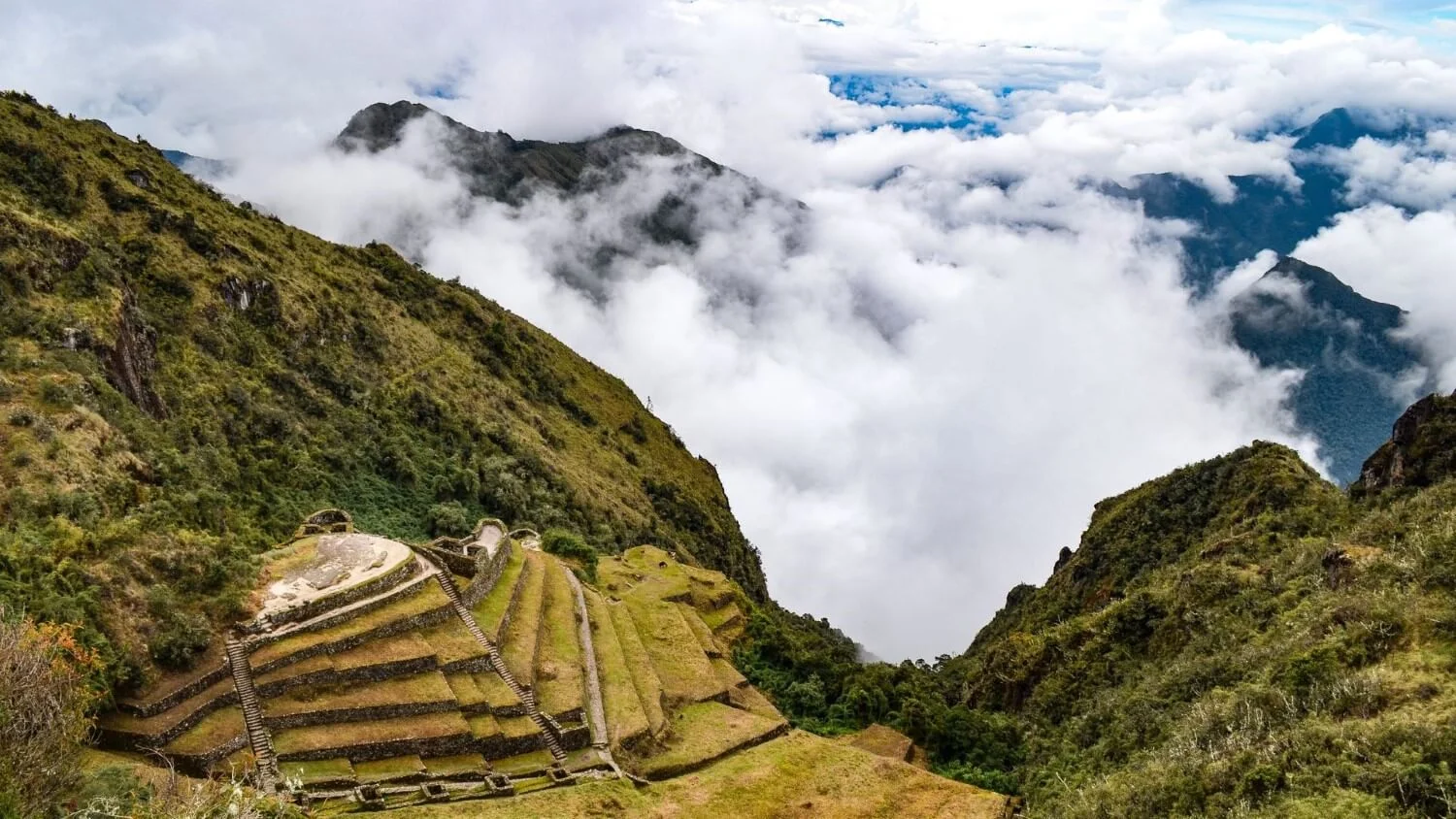
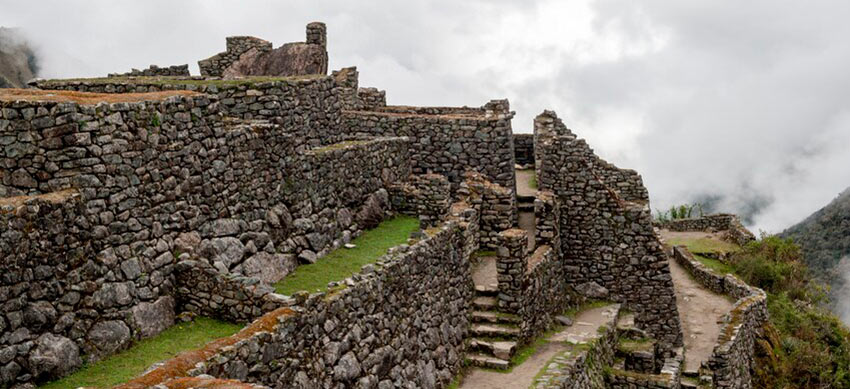
5. Intipata
This site is located near Wiñay Wayna and is characterized by its extensive sloping terraces. Intipata, which means “Place of the Sun”, was possibly an important agricultural area, and its panoramic views of the Urubamba River show the geographical beauty of the site.
6. Wiñay Wayna
This is the last archaeological site before reaching Machu Picchu. Its name means “Forever Young” and it is famous for its terraces and constructions located on the side of a mountain. Wiñay Wayna also includes water sources and ceremonial areas, suggesting its agricultural importance.
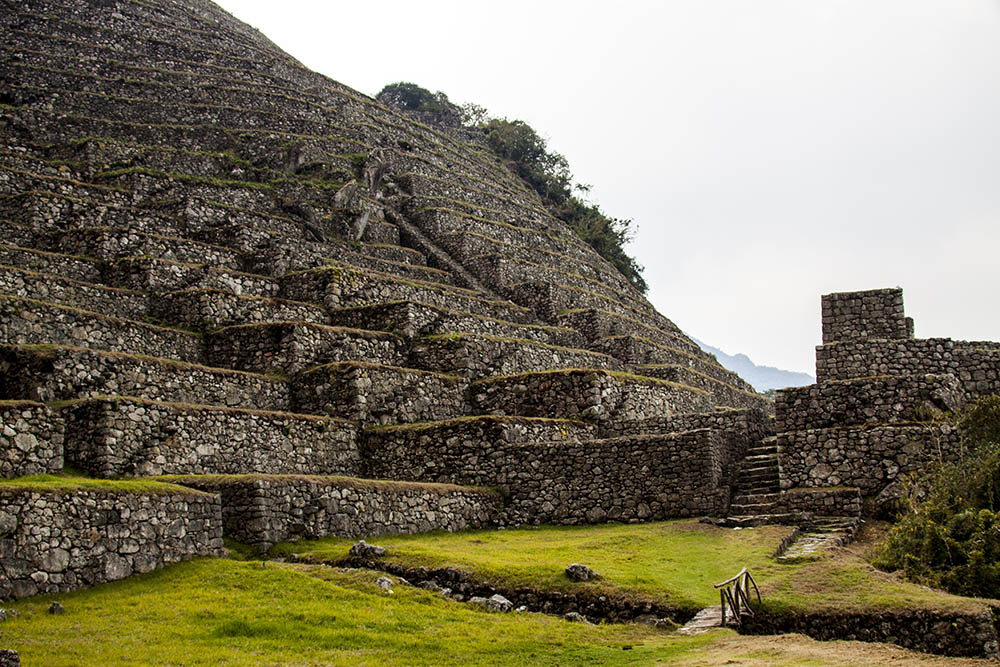

7. Inti Punku (Sun Gate)
The Sun Gate is the end point of the Inca Trail and the main entrance to Machu Picchu. This site serves as a checkpoint and offers the first view of the citadel, marked by the surrounding mountains. It is a strategic place to contemplate the majesty of Machu Picchu,
These archaeological sites not only enrich the tour with their beauty and complexity, but also allow hikers to immerse themselves in history.
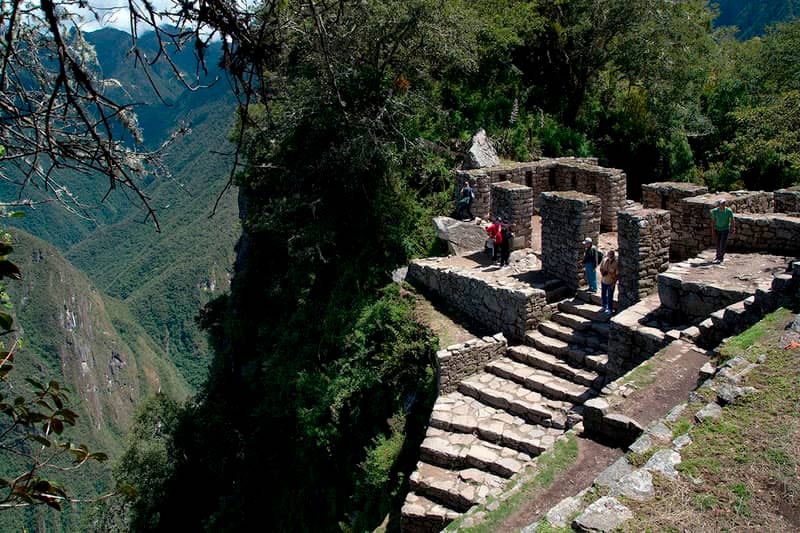
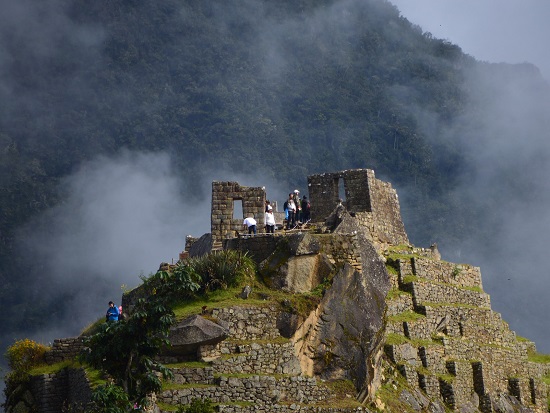
Resolving doubts : Common Questions about the Inca Trail Frequently Asked Questions (FAQs)
What is the Inca Trail?
The Inca Trail is a 43 kilometre trekking route that links the city of Cuzco with the citadel of Machu Picchu. It is a natural passage to get into the nature and have a more adventurous trip on the way to Machu Picchu.
Availability
- Limited number of trekkers: The Peruvian government establishes a daily limit of visitors, generally around 500 people, including guides and porters. This means that there are only a limited number of places available each day.
- High vs. low season: During the high season (June and July), it is more difficult to find availability as the dates get closer. In the low season (November to April), there may be more flexibility, but there is also more risk of unfavorable weather conditions.
Reservations
- Anticipation: It is recommended to make your reservation at least 3 to 6 months in advance, especially if you plan to go in high season. This is vital to secure your spot, as places sell out quickly.
- Authorized agencies: Reservations must be made through authorized trekking agencies, as they manage the necessary permits to access the Inca Trail. Make sure you choose a reliable agency that complies with regulations and offers experienced guides.
- Required documentation: To make a reservation, you will need a valid passport. Some agencies may ask for additional information, such as health details or dietary requirements.
- Permits: Once you make your reservation, the agency will process the necessary permits, which are personal and non-transferable. It is important to verify that your passport information is correct on the permit, as any mistake may prevent you from starting the trek.
- Cancellation policies: Check the agency’s cancellation policies. Due to high demand, some may have strict policies, so it is good to be informed.
Why is the Inca Trail famous?
The Inca Trail is famous for its natural beauty, history and cultural importance. The route passes through breathtaking landscapes, such as mountains, valleys, forests and waterfalls. It also offers the opportunity to visit ancient Inca ruins, such as Wayna Picchu and Machu Picchu.
Where is the Inca Trail located?
The Inca Trail is located in the Peruvian Andes, in the Cusco region. The trail begins in the city of Cusco and ends at the citadel of Machu Picchu, which is located on top of a mountain.
Inca Trail during rainy season what to take into account
The Inca Trail during the rainy season, which generally runs from November to March, presents a different landscape and a cooler environment. The rains can be heavy, which means that the trails can become slippery and some sections may be closed for safety or landslides. However, the landscapes are green and lush, offering spectacular views.
Here are some recommendations if you plan to hike the Inca Trail at this time of year:
1. Adequate preparation: Wear waterproof and layered clothing, as temperatures can vary. Don’t forget a good pair of hiking boots with good grip.
2. Planning: Check with trekking agencies about the condition of the trails before setting out. Some parts may be closed.
3. Essential equipment: Include a light backpack, a good raincoat, and make sure you have a rain poncho.
4. Follow instructions: If you are in a group, follow the directions of your guide, as they will know the best routes and safety measures.
5. Hydration and snacks: Bring enough water and energy food, as physical exertion increases in wet conditions.
6. Flexibility: Be prepared for changes in the itinerary due to weather conditions.
Remember that, although the rains can present challenges, the Inca Trail in this season also offers a unique and less crowded experience.
Inca Trail during dry season to keep in mind
During the dry season, which runs from May to October, the Inca Trail offers a more stable and sunny climate, ideal for trekking. Temperatures are pleasant during the day, but can drop considerably at night, so it is important to be prepared for both extremes.
Here are some things to keep in mind:
1. trail conditions: the trails are usually in better condition, as there is no rainfall to cause mud or slides. However, some sections can be very dusty.
Crowds: This is the most popular time to hike the Inca Trail, so you will find more tourists. If you prefer less crowds, consider starting your trek early in the season.
3. Advance reservations: Due to high demand, it is crucial to reserve your place in advance, as access to the Inca Trail is limited.
4. Adequate equipment: Wear light and breathable clothing for the day, but don’t forget a coat for the cold nights. It is also advisable to use sunscreen and bring enough water.
5. Hydration: Dry weather can dehydrate you faster, so be sure to drink enough water throughout the day.
6. Physical condition: Be physically prepared, as trekking can be demanding. A good physical condition will help you enjoy the experience more.
The dry season is ideal to enjoy the Inca Trail, as you can appreciate the beauty of the Andean landscape in all its splendor.
In what season of the year is it advisable to do the Inca Trail?
The best time to do the Inca Trail is during the dry season, which runs from May to October. This period offers a more favorable climate, with sunny days and pleasant temperatures, ideal for trekking.
Weather and conditions
– May to October: During these months, rainfall is scarce and skies are usually clear. Daytime temperatures range from 20°C to 25°C, while nights can be cold, dropping to around 0°C to 5°C, especially at higher elevations.
– November to April: This is the rainy season, where rainfall is more frequent. Although the landscape is greener and lusher, road conditions can become tricky, with slippery trails and possible landslides.
Advantages of the dry season
1. Visibility: The views are spectacular, with sunlit mountains and Andean landscapes, allowing for breathtaking photographs.
2. Less mud: Trails are more traversable, making trekking easier and minimizing the risk of falls.
3. Greater access: Most sections are open and in good condition, allowing for a smoother ride.
4. Complementary activities: With good weather, you can enjoy additional activities such as visits to other nearby archaeological sites.
Important considerations
– Reservations: Due to the high demand during this season, it is essential to make reservations in advance, as access to the Inca Trail is limited to a specific number of trekkers per day.
– Physical preparation: This trek is demanding, so it is advisable to prepare physically before starting the adventure. Endurance exercises and previous hikes will help you to adapt better.
– Adequate equipment: Take light clothes for the day, but also warm clothes for the cold nights. Don’t forget sun protection, insect repellent and enough water.
How long does the Inca Trail take?
The Inca Trail can be done in 4, 5 or 6 days. The duration depends on the type of trek you choose. The 4-day tours are the most popular, but the 5 or 6-day tours offer more time to explore the trail and the Inca ruins.
How much does the Inca Trail cost?
The price of the Inca Trail varies depending on the type of tour you choose. The 4-day tours usually cost between US$500 and US$1,000. Tours of 5 or 7 days usually cost between US$700 and US$1,500.
How to book a tour to the Inca Trail?
The only way to book an Inca Trail tour is through an authorized travel agency. Travel agencies offer a variety of Inca Trail tours to suit all budgets and fitness levels.
What should I pack for the Inca Trail?
It is important to pack comfortable clothing suitable for the trek. It is also important to pack waterproof clothing, as it can rain in the Andes. In addition, it is important to pack enough food and water for the trek.
What should I know before doing the Inca Trail?
It is important to be in good physical shape before doing the Inca Trail. The route is demanding and requires a good physical condition. It is also important to be prepared for the variable weather conditions in the Andes.
How to prepare physically for the Inca Trail?
It is important to start preparing physically for the Inca Trail at least six weeks before the trek. Regular walks are recommended, gradually increasing the distance and difficulty. It is also important to strengthen the muscles of the legs and buttocks.
What are the risks of the Inca Trail?
The main risks of the Inca Trail are altitude sickness, fatigue and injuries. It is important to be prepared for these risks and take the necessary measures to prevent them.
How can I leave feedback about my tour?
You can leave feedback about your tour on our Tripadvisor profile, by email or by phone. We appreciate your feedback and will use it to improve our tours.
Inquiry form
TIERRA BIRU EXPEDITIONS RECOGNITIONS
At Tierra Biru Expeditions, our mission is to craft unparalleled experiences for each of our clients. We curate journeys that leave an indelible mark, etching memories meant to last a lifetime. These are adventures you’ll take pride in, stories you’ll eagerly share with everyone around you. Discover the extraordinary with Tierra Biru Expeditions
TRIPADVISOR












